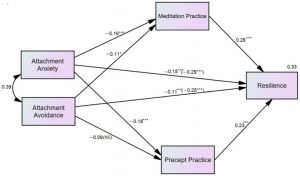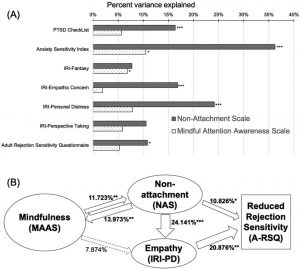
Reduce Cell Phone Withdrawal Anxiety with Mindfulness
By John M. de Castro, Ph.D.
“It isn’t just the plethora of tech offerings that keep us feeling preoccupied and divided, it is our relationship to these devices that keep us wanting more.” – Sura
Over the last few decades cell phones have gone from a rare curiosity to the dominant mode of electronic communications. They have also expanded well beyond a telephone and have become powerful hand-held computers known as smartphones. In fact, they have become a dominant force in daily life, occupying large amounts of time and attention. We have become seriously attached. They have become so dominant that, for many, the thought of being without it produces anxiety. Many people have become addicted. It is estimated that about 12% of the population is truly “addicted,” developing greater levels of “tolerance” and experiencing “withdrawal” and distress when deprived of them.
Recent surveys and studies paint a vivid picture of our cell phone addiction: we feel a surge of panic when we are separated from our beloved cell phones. This has been given a name, nomophobia, “which is defined as the fear of being out of cellular phone contact, or “feelings of discomfort or anxiety experienced by individuals when they are unable to use their mobile phones or utilize the affordances these devices provide”. This phenomenon is so new that there is little understanding of its nature and causes. Obviously, nomophobia is ripe for scientific study.
In today’s Research News article “Individual Differences in the Relationship Between Attachment and Nomophobia Among College Students: The Mediating Role of Mindfulness.” (See summary below or view the full text of the study at: https://www.ncbi.nlm.nih.gov/pmc/articles/PMC5746620/ ), Ibrahim and colleagues study the relationships of this cell phone based phobia with attachment styles and mindfulness. They recruited undergraduate students and had them complete measurements of, attachment, mindfulness and nomophobia, with 4 subscales, “Unable to Access Information, Losing Connectedness, Unable to Communicate, and Giving Up Convenience.”
They noted that there were significant gender differences with women having significantly higher levels of anxious attachment and nomophobia than men. This suggests that women are emotionally more dependent and crave for more closeness and attention in their relationships than do men. and that women tend to become more dependent on their cell phones. So, just as women become more attached in their relationships, they also become more attached to their phones.
Ibrahim and colleagues also found that, overall, higher levels of both anxious and avoidant attachment were associated with higher levels of nomophobia and lower levels of mindfulness and higher levels of mindfulness were associated with lower levels of nomophobia. These results suggest that the attachment styles of cell phone users and their mindfulness are associated with the level of nomophobia, with anxious and avoidant attachment promoting nomophobia and mindfulness reducing it.
These results further suggest that people with more maladaptive styles of attachment, who are emotionally more dependent and crave more closeness and attention in their relationships, are also more prone to developing a phobia regarding their cell phones. On the other hand, people with high levels of mindfulness are less prone. So, mindfulness may, in part, be an antidote to nomophobia.
So, reduce cell phone withdrawal anxiety with mindfulness.
Those with mindfulness training were able to resist habitual behaviours — like instantly opening an email or text when it pops up — to focus their attention on individual tasks for longer. They began to make somewhat wiser choices about when to respond to something and when not to,” – David Levy
CMCS – Center for Mindfulness and Contemplative Studies
This and other Contemplative Studies posts are also available on Google+ https://plus.google.com/106784388191201299496/posts and on Twitter @MindfulResearch
Study Summary
Ibrahim Arpaci, Mustafa Baloğlu, Hatice İrem Özteke Kozan, Şahin Kesici. Individual Differences in the Relationship Between Attachment and Nomophobia Among College Students: The Mediating Role of Mindfulness. J Med Internet Res. 2017 Dec; 19(12): e404. Published online 2017 Dec 14. doi: 10.2196/jmir.8847
Abstract
Background
There is a growing interest in nomophobia, which is defined as the fear of being out of cellular phone contact, or “feelings of discomfort or anxiety experienced by individuals when they are unable to use their mobile phones or utilize the affordances these devices provide”. However, only limited research can be found in terms of its determinants at present. Contemporary literature suggests that the relationships among attachment styles, mindfulness, and nomophobia have not been investigated.
Objective
This study aims to investigate the mediating effect of mindfulness on the relationship between attachment and nomophobia. In addition, the study also focuses on gender differences in attachment, mindfulness, and nomophobia. A theory-based structural model was tested to understand the essentials of the associations between the constructs.
Methods
The Experiences in Close Relationships Scale, Nomophobia Questionnaire, and Mindful Attention Awareness Scale were used to collect data from undergraduate students (N=450; 70.9% women [319/450]; mean age=21.94 years [SD 3.61]). Two measurement models (ie, attachment and mindfulness) and a structural model were specified, estimated, and evaluated.
Results
The structural equation model shows that the positive direct effects of avoidant (.13, P=.03) and anxious attachment (.48, P<.001) on nomophobia were significant. The negative direct effects of avoidant (−.18, P=.01) and anxious attachment (−.33, P<.001) on mindfulness were also significant. Moreover, mindfulness has a significant negative effect on nomophobia for women only (−.13, P=.03). Finally, the Sobel test showed that the indirect effects of avoidant and anxious attachment on nomophobia via mindfulness were significant (P<.001). The direct and indirect effects of anxious attachment, avoidant attachment, and mindfulness altogether accounted for 33% of the total variance in nomophobia. Gender comparison results show that there is a significant difference in attachment based on gender (F2,447=6.97, P=.01, Wilk λ=.97, partial η2=.03). Women (mean 68.46 [SD 16.96]) scored significantly higher than men (mean 63.59 [SD 15.97]) in anxious attachment (F1=7.93, P=.01, partial η2=.02). Gender differences in mindfulness were not significant (F4,448=3.45, P=.69). On the other hand, results do show significant gender differences in nomophobia (F4,445=2.71, P=.03, Wilk λ=.98, partial η2=.02) where women scored significantly higher than men.
Conclusions
In general, individuals who are emotionally more dependent and crave more closeness and attention in the relationship tend to display higher levels of fear or discomfort when they have no access to their mobile phones. However, gender has a differential impact on the relationship between avoidant attachment and nomophobia. This study establishes the impact of mindfulness on nomophobia for women; therefore, future studies should test the effectiveness of mindfulness-based therapy approaches and confirm whether they are effective and efficient. On the basis of significant gender difference in nomophobia and attachment, we conclude that gender should be taken into account in mindfulness-based treatments dealing with nomophobia.
https://www.ncbi.nlm.nih.gov/pmc/articles/PMC5746620/








